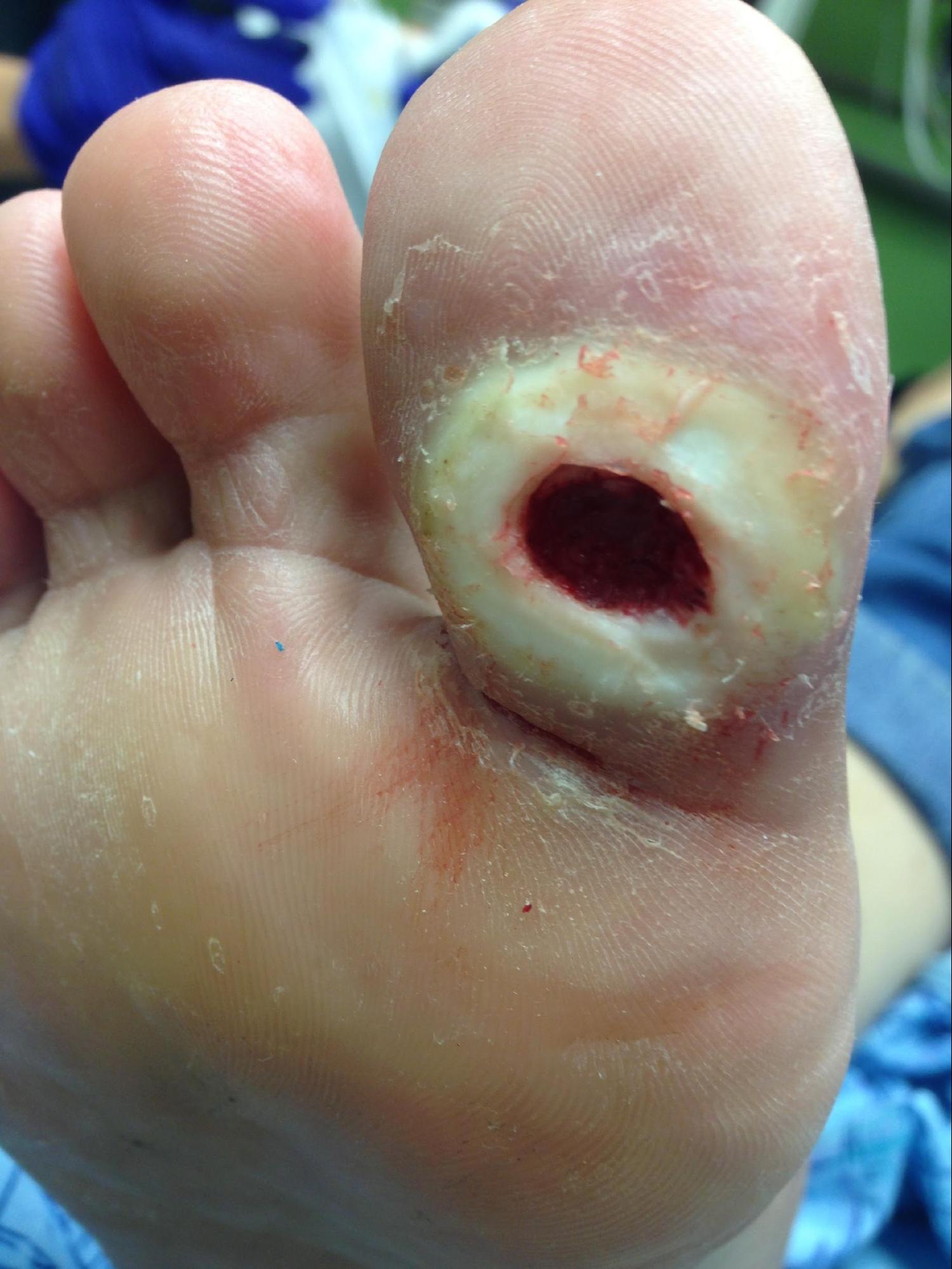[1]
Boulton AJ, Armstrong DG, Albert SF, Frykberg RG, Hellman R, Kirkman MS, Lavery LA, LeMaster JW, Mills JL Sr, Mueller MJ, Sheehan P, Wukich DK. Comprehensive foot examination and risk assessment. A report of the Task Force of the Foot Care Interest Group of the American Diabetes Association, with endorsement by the American Association of Clinical Endocrinologists. Physical therapy. 2008 Nov:88(11):1436-43
[PubMed PMID: 19137633]
[2]
Edmonds M, Bates M, Doxford M, Gough A, Foster A. New treatments in ulcer healing and wound infection. Diabetes/metabolism research and reviews. 2000 Sep-Oct:16 Suppl 1():S51-4
[PubMed PMID: 11054889]
[3]
McNeely MJ, Boyko EJ, Ahroni JH, Stensel VL, Reiber GE, Smith DG, Pecoraro RF. The independent contributions of diabetic neuropathy and vasculopathy in foot ulceration. How great are the risks? Diabetes care. 1995 Feb:18(2):216-9
[PubMed PMID: 7729300]
[4]
Uçkay I, Aragón-Sánchez J, Lew D, Lipsky BA. Diabetic foot infections: what have we learned in the last 30 years? International journal of infectious diseases : IJID : official publication of the International Society for Infectious Diseases. 2015 Nov:40():81-91. doi: 10.1016/j.ijid.2015.09.023. Epub 2015 Oct 13
[PubMed PMID: 26460089]
[5]
Gariani K, Uçkay I, Lipsky BA. Managing diabetic foot infections: a review of the new guidelines. Acta chirurgica Belgica. 2014 Jan-Feb:114(1):7-16
[PubMed PMID: 24720132]
[6]
Geraghty T, LaPorta G. Current health and economic burden of chronic diabetic osteomyelitis. Expert review of pharmacoeconomics & outcomes research. 2019 Jun:19(3):279-286. doi: 10.1080/14737167.2019.1567337. Epub 2019 Jan 21
[PubMed PMID: 30625012]
[7]
Zhang X, Sun D, Jiang GC. Comparative efficacy of nine different dressings in healing diabetic foot ulcer: A Bayesian network analysis. Journal of diabetes. 2019 Jun:11(6):418-426. doi: 10.1111/1753-0407.12871. Epub 2018 Nov 25
[PubMed PMID: 30324760]
Level 2 (mid-level) evidence
[8]
Levy N, Gillibrand W. Management of diabetic foot ulcers in the community: an update. British journal of community nursing. 2019 Mar 1:24(Sup3):S14-S19. doi: 10.12968/bjcn.2019.24.Sup3.S14. Epub
[PubMed PMID: 30817189]
[9]
Bolton L. Managing Patients With Diabetic Foot Ulcers. Wounds : a compendium of clinical research and practice. 2018 Dec:30(12):380-381
[PubMed PMID: 30507549]
[10]
Parker CN, Shuter P, Maresco-Pennisi D, Sargent J, Collins L, Edwards HE, Finlayson KJ. Implementation of the Champions for Skin Integrity model to improve leg and foot ulcer care in the primary healthcare setting. Journal of clinical nursing. 2019 Jul:28(13-14):2517-2525. doi: 10.1111/jocn.14826. Epub 2019 Mar 24
[PubMed PMID: 30791154]
[11]
Borys S, Hohendorff J, Frankfurter C, Kiec-Wilk B, Malecki MT. Negative pressure wound therapy use in diabetic foot syndrome-from mechanisms of action to clinical practice. European journal of clinical investigation. 2019 Apr:49(4):e13067. doi: 10.1111/eci.13067. Epub 2019 Jan 29
[PubMed PMID: 30600541]
[12]
Giacomozzi C, Sartor CD, Telles R, Uccioli L, Sacco ICN. Ulcer-risk classification and plantar pressure distribution in patients with diabetic polyneuropathy: exploring the factors that can lead to foot ulceration. Annali dell'Istituto superiore di sanita. 2018 Oct-Dec:54(4):284-293. doi: 10.4415/ANN_18_04_04. Epub
[PubMed PMID: 30575564]
[13]
American Diabetes Association. 2. Classification and Diagnosis of Diabetes: Standards of Medical Care in Diabetes-2018. Diabetes care. 2018 Jan:41(Suppl 1):S13-S27. doi: 10.2337/dc18-S002. Epub
[PubMed PMID: 29222373]
[14]
Ndosi M, Wright-Hughes A, Brown S, Backhouse M, Lipsky BA, Bhogal M, Reynolds C, Vowden P, Jude EB, Nixon J, Nelson EA. Prognosis of the infected diabetic foot ulcer: a 12-month prospective observational study. Diabetic medicine : a journal of the British Diabetic Association. 2018 Jan:35(1):78-88. doi: 10.1111/dme.13537. Epub 2017 Nov 20
[PubMed PMID: 29083500]
Level 2 (mid-level) evidence
[15]
Apelqvist J, Larsson J, Agardh CD. Long-term prognosis for diabetic patients with foot ulcers. Journal of internal medicine. 1993 Jun:233(6):485-91
[PubMed PMID: 8501419]
[16]
Muduli IC, P P A, Panda C, Behera NC. Diabetic Foot Ulcer Complications and Its Management-a Medical College-Based Descriptive Study in Odisha, an Eastern State of India. The Indian journal of surgery. 2015 Dec:77(Suppl 2):270-4. doi: 10.1007/s12262-012-0791-2. Epub 2013 Mar 9
[PubMed PMID: 26730008]
[17]
Boulton AJ. Diabetic neuropathy and foot complications. Handbook of clinical neurology. 2014:126():97-107. doi: 10.1016/B978-0-444-53480-4.00008-4. Epub
[PubMed PMID: 25410217]
[18]
Megallaa MH, Ismail AA, Zeitoun MH, Khalifa MS. Association of diabetic foot ulcers with chronic vascular diabetic complications in patients with type 2 diabetes. Diabetes & metabolic syndrome. 2019 Mar-Apr:13(2):1287-1292. doi: 10.1016/j.dsx.2019.01.048. Epub 2019 Jan 24
[PubMed PMID: 31336479]
[19]
Lázaro-Martínez JL, Aragón-Sánchez J, García-Morales E. Antibiotics versus conservative surgery for treating diabetic foot osteomyelitis: a randomized comparative trial. Diabetes care. 2014:37(3):789-95. doi: 10.2337/dc13-1526. Epub 2013 Oct 15
[PubMed PMID: 24130347]
Level 2 (mid-level) evidence
[20]
Ammendola M, Sacco R, Butrico L, Sammarco G, de Franciscis S, Serra R. The care of transmetatarsal amputation in diabetic foot gangrene. International wound journal. 2017 Feb:14(1):9-15. doi: 10.1111/iwj.12682. Epub 2016 Oct 3
[PubMed PMID: 27696694]
[21]
Dorresteijn JA, Kriegsman DM, Assendelft WJ, Valk GD. Patient education for preventing diabetic foot ulceration. The Cochrane database of systematic reviews. 2014 Dec 16:2014(12):CD001488. doi: 10.1002/14651858.CD001488.pub5. Epub 2014 Dec 16
[PubMed PMID: 25514250]
Level 1 (high-level) evidence
[22]
Nather A, Cao S, Chen JLW, Low AY. Prevention of diabetic foot complications. Singapore medical journal. 2018 Jun:59(6):291-294. doi: 10.11622/smedj.2018069. Epub
[PubMed PMID: 29974120]
[23]
Xiang J, Wang S, He Y, Xu L, Zhang S, Tang Z. Reasonable Glycemic Control Would Help Wound Healing During the Treatment of Diabetic Foot Ulcers. Diabetes therapy : research, treatment and education of diabetes and related disorders. 2019 Feb:10(1):95-105. doi: 10.1007/s13300-018-0536-8. Epub 2018 Nov 21
[PubMed PMID: 30465160]
[24]
Lim JZ, Ng NS, Thomas C. Prevention and treatment of diabetic foot ulcers. Journal of the Royal Society of Medicine. 2017 Mar:110(3):104-109. doi: 10.1177/0141076816688346. Epub 2017 Jan 24
[PubMed PMID: 28116957]



